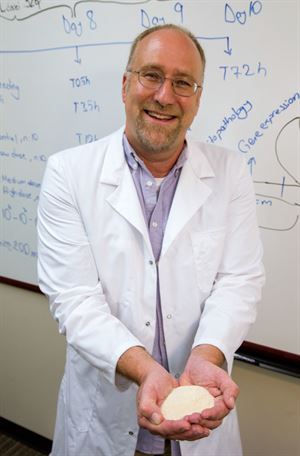Steele studies infection-fighting power of a new probiotic bacterium

To an untrained eye, the bubbling beaker in Jim Steele’s lab looks like a good idea gone bad.
As a lab assistant lifts the glass from its warm water bath, a turbid brown liquid swirls inside. It certainly won’t win any beauty contests.
But it might save your life — at just 3 cents per serving.
Steele, a food scientist with the College of Agricultural and Life Sciences, has spent months creating a laboratory simulation of the human gastrointestinal tract and other test regimens as he works to develop a food additive that will protect against the ravages of Clostridium difficile bacteria. Each year, some 14,000 U.S. hospital patients die from C. difficile infection and thousands more develop serious complications from the bacteria, which causes severe diarrhea and other intestinal illnesses among patients whose natural gut microbiota has been altered by antibiotic treatment.
C. difficile bacteria are notoriously difficult to eradicate from common surfaces and thrive in environments such as hospitals and nursing homes where residents often have compromised immune systems. As a result, Steele says, his work promises important medical and scientific advances.
“From a broad scientific perspective, we’re trying to understand how probiotics work,” Steele says. “More specifically, we’ve identified several strains of bacteria that stimulate a significant, protective response against clostridia. Through the Accelerator Program, we’re working to identify the right strain and right dosage to create the greatest benefit for patients.”
By now, most consumers are familiar with the benefits of probiotics listed on the labels of some yogurt and other food products. Depending on the type of probiotic bacteria used, the health benefits may range from improved digestion to immune system support.
Until Steele’s work, however, few understood the tremendous genetic variability of specific kinds of beneficial, probiotic bacteria. His team is focusing on Lactobacillus casei, an organism found in a wide range of environments, including the human mouth, ripening cheese and decomposing green plant material.
“The interesting thing about L. casei is the tremendous genetic variability, a large part of which arose about 8,000 to 10,000 years ago during the domestication of dairy cattle and advent of cheese production,” Steele says. “Our work in genome sequencing indicates that on average, only about 60 percent of the genes are conserved while about 40 percent are variable. This means that L. casei strains differ from each other by hundreds of genes, and this variability opens up possibilities related to targeted strain-specific therapeutic benefits.”
However, substantiating the benefits of a specific L. casei strain against dangerous C. difficile infections has meant thousands of hours of work for Steele, his graduate assistants and collaborators: Nasia Safdar from UW-Madison’s School of Medicine and Public Health; Benjamin Darien from the School of Veterinary Medicine; and Eric Johnson from the department of bacteriology.
Among the challenges has been creating a model system that replicates the harsh conditions present in the human gastrointestinal tract.
The system has been used to select L. casei strains that can survive passage to the small intestine, where it is hypothesized that they stimulate the host immune system to fight the C. difficile infection.
Other significant challenges have involved validating animal models of the disease. For example, certain breeds of laboratory mice don’t display measurable symptoms of C. difficile infection while others succumb too quickly to the disease.
Steele’s team also has been hard at work narrowing the potential strains of L. casei down to a few top performers. He started by isolating a promising group of samples drawn from wine isolates, corn silage, cheese and fecal samples. Now, with Accelerator Program funding, he is preparing to begin a final round of testing in mice. If the effort proceeds as expected, human clinical trials could be on the horizon.
Part of the beauty of L. casei is that this organism has been consumed safely by humans for thousands of years and hence the selected strain can be manufactured through routine processes similar to those already in place in the food industry. The relative ease of production and high volume processes also mean that an L. casei probiotic could be available at approximately 3 cents per serving, a commercially viable price.
“That’s a very reasonable price given the tremendously high costs associated with treating C. difficile infections and the potential lifelong health implications,” Steele says. “Given the public acceptance of probiotics and the ease of eating a cup of yogurt or smoothie every day during a hospital stay and for a time afterwards, the invention would have real potential to help people.”